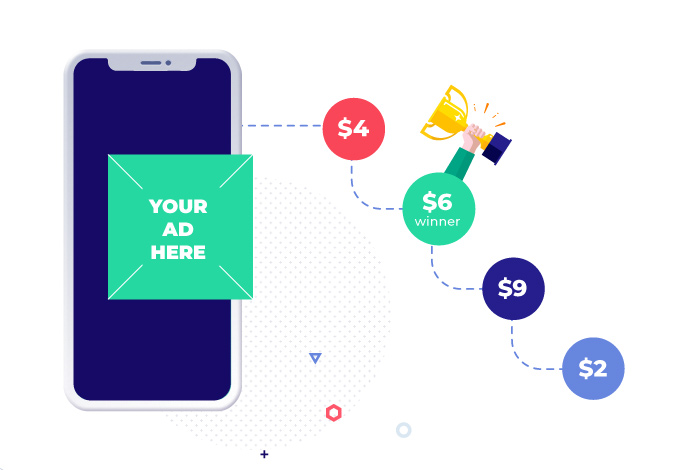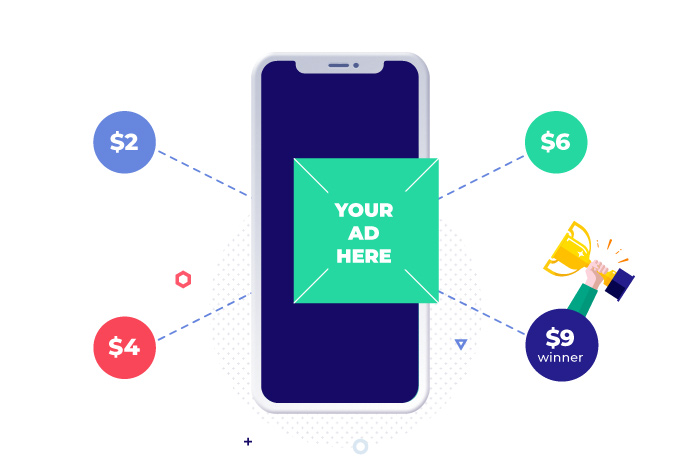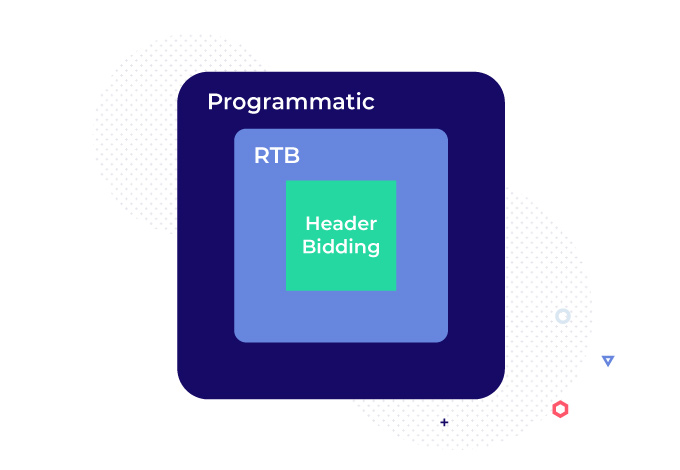Who doesn’t love the buzzing world of the ad-tech industry? It revolutionized online retail as we know it today, and gave way to billion-dollar profits for all parties involved — publishers, advertisers, and affiliates alike! But…
How does the magic happen? What propels the ad display? And what solution, waterfall or header bidding, makes the most money?
Whether you’re into web or in-app advertising (or both!) you’ve just found yourself in the right place.
Programmatic Advertising — the new medium of connecting with your audience.
Programmatic advertising is a real-time, almost fully automated process of buying and selling online ad inventory. Sounds easy enough, right?
But programmatic media buying is much more. It’s a complex yet extremely successful way of connecting brands with their audiences. The traditional, brick-and-mortar advertising model, involves buyers and sellers discussing, negotiating, and spending an awful lot of time getting their ads out for the people to see them. While programmatic marketing allows advertisers to get their ads right in front of the customers’ eyes (since that’s where the people are looking anyhow, constantly checking our phones and laptops) within split seconds.
Other benefits of programmatic advertising include advanced targeting, precise data tracking, and real-time analytics, allowing marketers to optimize campaigns exactly when and where it’s needed to maximize their ROIs.
So, how does the magic happen?
Well… online publishers offer advertising space, and advertisers auction to win ad placements. And that’s exactly where waterfall and header bidding come into play.
Waterfall bidding explained!
The waterfall bidding process, also known as daisy-chaining or waterfall tags, is one of the two most popular ways to buy and sell online ad inventory in programmatic advertising. The waterfall model can be even said to have started programmatic advertising as such.
During the waterfall bidding process, a publisher (seller) offers ad impressions to ad networks (buyers) for a fixed minimum price per impression (floor bid) in sequential order. That means if the publisher offers an ad impression for a minimum price of $0.02, it will be sold to the first ad network it is offered that meets the floor bid.
Now, the ad networks don’t just come in the waterfall sequence randomly. They are organized in a fixed order, too.
This order depends on the ad network’s priority. If the demand partner ranks higher thanks to its average historical yield, it’s granted a higher priority over other ad networks. And since the impressions inventory is offered sequentially, if a higher priority network meets the minimum bid, even when the next buyer pays double for that impression, it goes to the first buyer in a sequence that meets the price.
Yes, there’s actually very little bidding involved in the waterfall bidding process. Leaving all other ad networks in the sequence without the chance of winning impressions, and publishers without the chance of making more money by selling their inventory to those who are willing to pay more.
The next network in a sequence would only get a chance to win that impression if the first one failed to provide an ad. So, ad impressions would be passed to the next buyers just like the waterfall would fill the next reservoirs.

Header bidding explained!
Header bidding, the second of the two most popular methods of auctioning programmatic ad inventory between the publishers and ad networks, offers the real bidding ecosystem.
The header bidding method allows publishers to send ad requests to all available demand partners simultaneously. Ad networks return their bids and the highest one wins!
This, of course, happens within a given time-limit. Otherwise, the process could be endless or worked on the first-come, first-serve terms which also wouldn’t be fair. Another huge advantage to the header bidding method is that it allows publishers to drastically improve the ad yield, being able to offer impressions to demand partners willing to buy more inventory that would otherwise never get a chance to even take part in the bidding process.
In short, the header bidding auction takes less than a second, allows publishers to maximize their profits, and advertisers to get an equal chance of winning traffic.

Why waterfall bidding used to be a thing…
The waterfall bidding system, though not perfect, came in first and, at that time, solved the most pressing issues for publishers and advertisers alike.
First, it automated the process of early ad placements where publishers and advertisers had to get in touch directly to strike a deal. And second, it increased the publisher’s fill rates while modern algorithms were still unavailable.
The by-product of the change from direct to waterfall advertising model was also the development of SSPs (Supply Side Platforms) and DSPs (Demand Side Platforms) that even further influenced the ad-tech industry.
…and how header bidding took over the ad-tech industry!
Still, despite the waterfall model’s benefits when it was first introduced, the industry agrees that the days of daisy-chaining are long gone now, giving way to the header bidding model.
Some of the top benefits of header bidding for publishers are:
- Increased revenue — since the highest bid wins the header bidding auction, publishers are able to capitalize on the market competition.
- Demand control — the header bidding still provides publishers with the ability to control their partners and decide who’s allowed to enter the bidding.
- Improved fill rates — unlike with a waterfall sequencing, there’s no risk of the auction taking too long due to demand’s partner failure of delivering the ad impression and the need to re-opening the process all over again.
Some of the top benefits of header bidding for advertisers are:
- Exposure — advertisers who may have never got a chance with huge opponents (due to their yield rankings) are now equally equipped to compete for ad impressions.
- Market competitiveness — thanks to ‘the highest bid wins’ instead of ‘the first partner in the sequence who meets the minimum bid wins’ advertisers are now able to estimate the real market competitiveness of publishers and decide how much they actually want to bid for a given placement.
- Ad-tech development — naturally, with the introduction of modern algorithms allowing for full automation of the ad-tech industry, advertisers are now able to run their business on various platforms and channels, thus ensuring new business opportunities.
Header bidding vs. RTB auctions.
Given you’re interested in the ad-tech selling and buying models you’ve surely heard yet another term, the Real-time bidding model.
The Real-time bidding model allows advertisers to bid for ad impressions in real-time, just like the header bidding model. That’s why they’re often thought to be the very same thing, but the RTB is a broader of the two terms actually. RTB often involves header bidding but doesn’t have to.
RTB’s protocol may be based on more than just the header bidding method. For example, using older methods like ad tags or the SDK (Software Development Kit) and still making it possible for the actual bidding to take place, just like in the case of header bidding auction.
If we were to describe the RTB’s process from the advertiser’s perspective, there’s basically no difference:
“The Real-time bidding model allows advertisers to bid for ad impressions in real-time. Once a user tries to enter a given page and the website loads, an ad request is sent to a traffic source. The platform then responds with a bid that was previously set by an advertiser during his campaign set-up, and once the bid is received, the winning ad is displayed to a user. All happening within split seconds! This bidding model enables marketers to broaden their reach and pay only for ads that users get to see. Also, it allows the website publishers to get the best value for their advertising space.
Implementation of the RTB model has surely revolutionized the ad tech industry. It cut the costs, helped increase the demand, and enabled new targeting options. Hence, helping to boost campaign performance and maximize the profits.”

Header bidding for in-app advertising — what took so long?
The header bidding became the new normal for desktop and mobile web advertising, sweeping the ad-tech industry since the day it was introduced. But how did it reflect on mobile in-app advertising? It definitely made them much slower… here’s why.
As much as header bidding came into existence as a web desktop solution, it was quickly adopted to the web mobile world, too. Sadly, things don’t function nearly the same for in-app advertising, causing it a bit of a struggle for mobile app developers and publishers to compromise on the ad monetization model.
A struggle that needed to be resolved quickly given the mind-boggling adoption of mobile devices, and the ever-growing trend of mobile apps among users all over the world.
One of the key objectives in developing in-app advertising model from the apps publisher’s perspective was to keep the user-first approach. While still being able to capitalize on the advertising profits, especially needed by the free apps’ creators.
This is due to the sole reason why apps became an instant game-changer for the mobile-driven audience. They offer a one-second wait time with the minimum (or none at all) ad display.
So, how to bring user-experience, ad-monetization, market versatility, and competitiveness to one table?
First of all, that’s why new ad formats emerged, meant specifically for mobile apps. In-app ads offer a more user-centered rather than an advertiser-focused approach. Naturally, contrary to most of the web ads we’re used to.
Now, the ideal in-app advertising model would be able to keep that rule while delivering a quick, effective, and diversified ad solution to both publishers and advertisers. And here’s where the advertising history repeats itself.

Same problem, different struggle — transforming the mobile ad-tech industry.
Although no one argues the victory of header bidding over waterfall sequencing, it turned out to be a different story for in-app advertising from the technical point of view.
To begin with, there are no browser-header elements in mobile apps. Therefore, the pattern couldn’t be simply replicated for the in-app environment. But, was ever anything easy while developing the ad-tech industry?
The next objective said to be a problem was the fact that header bidding requires app publishers to take on more SDKs. This was claimed to further hinder the app’s development, triggering a whole sequence of changes — like a domino effect. These changes were then claimed to negatively affect the user-first approach.
That’s why the waterfall bidding model was incorporated. Though far from ideal, it was much simpler in the technical terms. Hence, a go-to solution once in-app advertising was first introduced. Soon enough, though, the benefits of the header bidding over the waterfall model became more and more significant for app publishers, too. Consequently, steps were taken to bring the header model closer to in-app advertising.
From sequencing to header bidding in in-app advertising.
As could be expected, the ad-tech industry rushed to provide solutions that would satisfy mobile app publishers’ needs, both in terms of the user-centered approach and ad-revenue opportunity.
This led to coming up with SSPs acting as mediation platforms, a header bidding panacea that allowed for securing all major SDKs integration for them
Once such SSPs (again, mediation partners responsible for integrating all major ad networks, ad exchanges, and DSPs) start a unified auction happening in real-time on the publisher’s in-app inventory, they call for the highest bid, thus making header bidding possible.
As opposed to the previously used waterfall bidding, greater market competitiveness, and demand diversity for in-app advertising were finally made possible, while allowing publishers to get the highest price per impression.
Conclusions
Now, to make everything crystal clear, here’s a detailed list of all the benefits and pain-points of the two bidding methods. Including the in-app advertising sector!
The waterfall bidding process:
✘ Limited market diversity.
✘ Limited revenue opportunities.
✘ Difficult to maintain due to lack of automation.
✘ The first buyer who meets the minimum bid price wins.
✘ Demand partners are prioritized based on their historical yield.
✘ Sequencing may cause delays in page-load speed.
✘ Unsold impressions cause lower fill rates.
✔︎ Standard ad tag (easily possible for in-app advertising).
✔︎ Low competition (for first-line advertisers)
The header bidding process:
✘ High competition
✘ Header tag (not possible for in-app advertising, yet substituted with SSPs as mediation platforms)
✔︎ Allows advanced automation
✔︎ The highest bid wins.
✔︎ All advertisers are able to bid on offered impressions.
✔︎ Quick and effective real-time bidding.
✔︎ High fill rates.
✔︎ Maximized revenue opportunities.
✔︎ Diversified demand.
Monetize Your Inventory with Zeropark!
Contact us
Kinga Gawron


